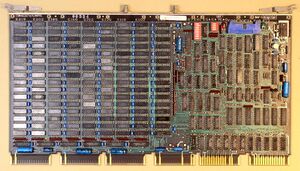Difference between revisions of "MS11-L MOS memory"
(current rqmts) |
(+Image) |
||
| Line 1: | Line 1: | ||
| + | [[Image:MS11-L.jpg|300px|thumb|right|MS11-L board]] | ||
| + | |||
The '''MS11-L''' was final [[UNIBUS]] [[main memory]] from [[Digital Equipment Corporation|DEC]]; a single card can hold enough [[Metal Oxide Semiconductor|MOS]] [[Dynamic RAM|DRAM]] [[integrated circuit|chips]] to fill the entire UNIBUS [[address space]]. It had a [[jumper]] option to enable use on an [[Extended UNIBUS]]. Configuration is by [[Dual Inline Package|DIP]] switches. It used on-board[[parity]] for error detection. | The '''MS11-L''' was final [[UNIBUS]] [[main memory]] from [[Digital Equipment Corporation|DEC]]; a single card can hold enough [[Metal Oxide Semiconductor|MOS]] [[Dynamic RAM|DRAM]] [[integrated circuit|chips]] to fill the entire UNIBUS [[address space]]. It had a [[jumper]] option to enable use on an [[Extended UNIBUS]]. Configuration is by [[Dual Inline Package|DIP]] switches. It used on-board[[parity]] for error detection. | ||
Revision as of 18:53, 25 January 2020
The MS11-L was final UNIBUS main memory from DEC; a single card can hold enough MOS DRAM chips to fill the entire UNIBUS address space. It had a jumper option to enable use on an Extended UNIBUS. Configuration is by DIP switches. It used on-boardparity for error detection.
Fully populated with 16Kx1 chips, it is known as the MS11-LD, and holds 256K bytes. The quarter-, half- and three-quarter-populated versions are the MS11-LA, -LB and -LC, respectively; with 64KB, 128KB and 192KB.
It plugs into a MUD backplane (only; not SPC). It is a single hex card, the M7891, so it cannot go in the end slots of the backplane.
The access time is 385 nsec (typical; 1025 nsec maximum on refresh conflict), and the cycle time is 510 nsec (1050 nsec maximum on refresh conflict). Refresh time is 570 nsec (typical; 610 nsec maximum); the time for a complete refresh pass is 14.5 μsec (typical), 13.5 μsec (minimum).
It can use either +/-15V or +/-12V to power the memory chips (in some MUD slots, the 15V pins provide 12V). The board has provision to use battery backup power to retain data during a power outage. Power requirements are 1.5-1.8A of +5V, 1-1.3A of +5VBB, 9-20mA of -12/-15V (depending on size, i.e. number of MOS memory chips), and 485-700 mA of +12/+15 (when active; depending on size).
| v • d • e PDP-11 Computers and Peripherals |
|---|
| UNIBUS PDP-11s - PDP-11/20 • PDP-11/15 • PDP-11/35 • PDP-11/40 • PDP-11/45 • PDP-11/50 • PDP-11/55 • PDP-11/70 PDP-11/05 • PDP-11/10 • PDP-11/04 • PDP-11/34 • PDP-11/60 • PDP-11/44 • PDP-11/24 • PDP-11/84 • PDP-11/94 QBUS PDP-11s - PDP-11/03 • PDP-11/23 • PDP-11/23+ • MicroPDP-11/73 • MicroPDP-11/53 • MicroPDP-11/83 • MicroPDP-11/93 QBUS CPUs: LSI-11 • LSI-11/2 • KDF11-A • KDF11-B • KDJ11-A • KDJ11-B • KDJ11-D • KDJ11-E Buses: UNIBUS • UNIBUS map • SPC • MUD • EUB • QBUS • CD interconnect • PMI Also: PDP-11 architecture • PDP-11 Extended Instruction Set • FP11 floating point • PDP-11 Memory Management |
| UNIBUS CPUs: KA11 • KC11 • KB11-A • KB11-B • KB11-C • KB11-D • KD11-A • KD11-B • KD11-D • KD11-E • KD11-EA • KD11-K • KD11-Z • KDF11-U
Co-processors: FP11-A • FP11-B • FP11-C • FP11-E • FP11-F • KE44-A • FPF11 Chips: LSI-11 • KEV11-A • KEV11-B • KEV11-C • F-11 • KEF11-A • KTF11-A • T-11 • J-11 • FPJ11 CPU options: KE11-E • KE11-F • KJ11-A • KT11-C • KT11-D • KK11-A • KK11-B • KT24 • KTJ11-B Rare CPU options: KS11 Memory Protection and Relocation option • KT11-B Paging Option • KUV11 Writeable Control Store Front panels: KY11-A • KY11-D • KY11-J • KY11-LA • KY11-LB • KY11-P More on buses: UNIBUS and QBUS termination • Bus Arbitration on the Unibus and QBUS • CTI BUS PDT-11s - PDT-11/110 • PDT-11/130 • PDT-11/150 CTI PDP-11s - PRO-325 • PRO-350 • PRO-380 Other: FIS floating point • PDP-11 Commercial Instruction Set • PDP-11 stacks • PDP-11 family differences |
